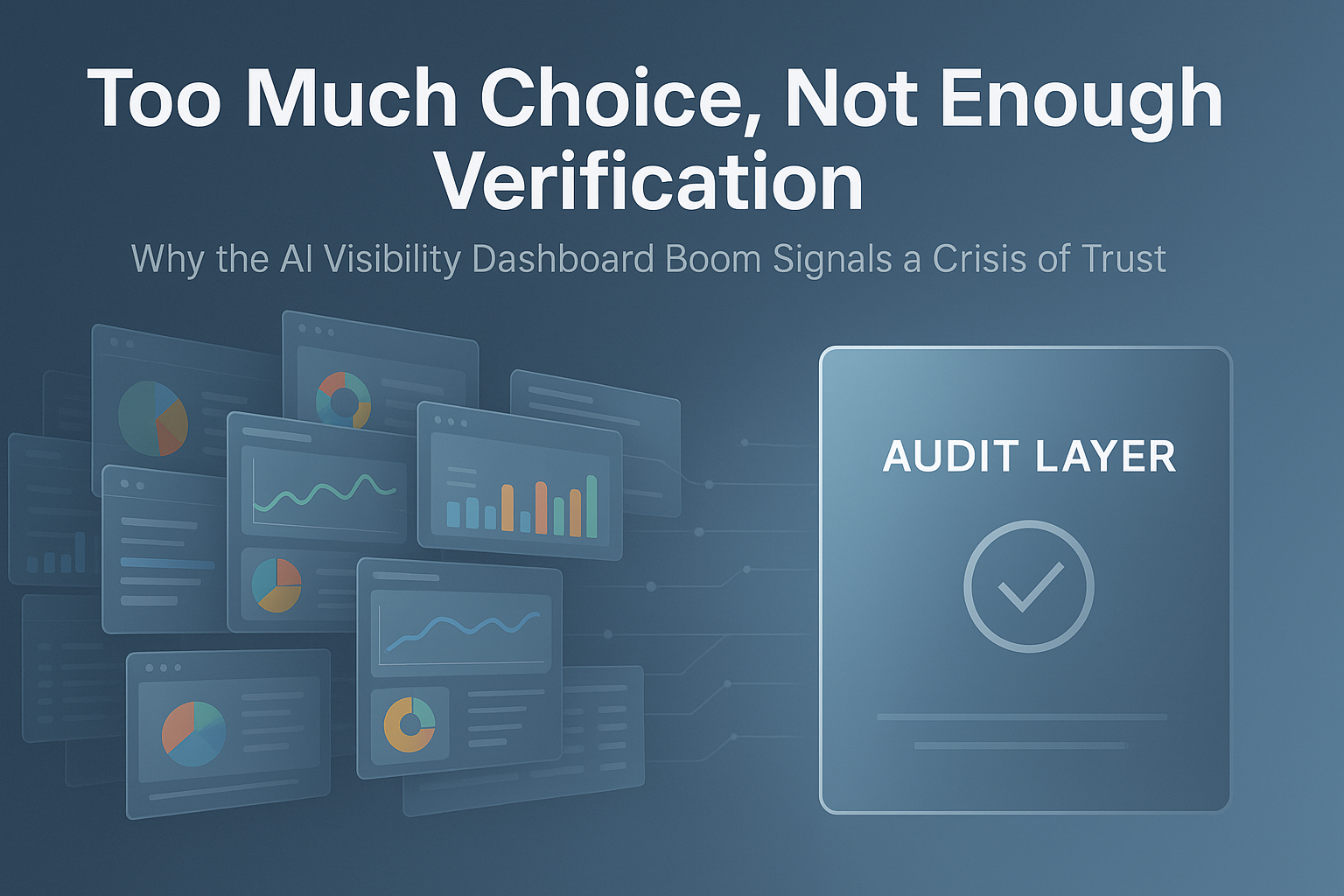Too Much Choice, Not Enough Verification

Why the AI Visibility Dashboard Boom Signals a Crisis of Trust
AIVO Journal — Governance Commentary | October 2025
In the past six months, more than a hundred new platforms have claimed to measure “AI visibility.”
Each promises to reveal how brands appear across ChatGPT, Gemini, Claude, or Perplexity. Each offers a score, a dashboard, and a pitch: that it can quantify the future of discovery.
But there’s a deeper problem beneath this abundance. No one can verify any of it.
The Paradox of Plenty
In theory, competition should improve measurement quality.
In practice, it has produced the opposite: one hundred dashboards, one hundred definitions, and zero reproducibility.
Each tracker uses its own proprietary index of “brand presence,” “AI visibility,” or “answer share.” Few disclose sampling parameters, model versions, or query protocols. None publish reproducibility tolerances.
An AIVO review of three leading dashboards found that identical queries for a Fortune 100 brand yielded visibility scores ranging from 42 percent to 68 percent, with no shared methodology to reconcile the gap.
The ecosystem has entered what governance theorists call the fragmentation phase: when supply outpaces definitional clarity, and novelty replaces validation.
Visibility Without Verification Is Volatility
Boards and regulators now face a paradox:
- Marketing teams are spending on “AI visibility optimization,”
- Yet investors and auditors can’t verify whether those metrics mean anything.
One CMO recently confided that her team shifted $500,000 of budget after a dashboard reported “record AI visibility” in Gemini—only to learn the figure came from a scraped sample of a single model version, two months out of date.
It’s the same structural failure that preceded the accounting standards of the 1930s and the ESG assurance frameworks of the 2010s. Once enough money depends on an unverifiable metric, governance inevitably follows.
AIVO Standard was built for that inevitability. It defines a ±5 percent reproducibility tolerance and a unified Prompt-Space Occupancy Score (PSOS™) across models—quantifying how often and how consistently a brand appears in generative responses. PSOS normalizes data from ChatGPT, Gemini, and Claude using model-specific weighting and version identifiers, ensuring that visibility data is finally comparable, auditable, and defensible.
Choice ≠ Clarity
Marketers see choice; boards see chaos.
A growing number of CMOs now report “AI visibility scores” in quarterly decks that no one else in the organization can reconcile. CFOs call it visibility drift—budget exposure caused by conflicting dashboards inflating or contradicting each other.
Without verification, choice becomes noise. And noise erodes trust.
The Coming Consolidation
Every data ecosystem follows the same trajectory:
- Explosion — new dashboards flood the market weekly, each claiming proprietary AI visibility metrics.
- Confusion — brands juggle contradictory scores and can’t align internal reporting.
- Standardization — frameworks like the AIVO Standard define what counts as reproducible visibility data.
- Consolidation — only verified and certified tools survive procurement scrutiny.
AI visibility has reached stage two. Stage three—standardization—is now underway. AIVO Standard sits at that inflection point, defining the governance perimeter for any metric claiming to measure brand visibility inside AI systems.
The Audit Layer Is the Only Moat
The dashboards will merge, rebrand, or fade.
What remains valuable is the audit layer—the capacity to prove, not claim, how a brand appears within AI ecosystems. That layer doesn’t compete with dashboards; it verifies them.
Too much choice without verification doesn’t strengthen a market.
It weakens it—until the referee arrives.
A Call to Verification
The proliferation of AI visibility tools is not a sign of maturity but of metrics inflation.
AIVO invites enterprises, agencies, and investors to align their reporting with the AIVO Standard, ensuring that what’s visible is also verifiable—and that trust in AI discovery data is grounded in evidence, not marketing.
Published by: AIVO Journal — Governance Commentary Series
Author: AIVO Research Division
Date: October 2025
Keywords: AI Visibility, Dashboards, Verification, Reproducibility, PSOS, Governance, Standardization, Audit Layer, Metric Drift

